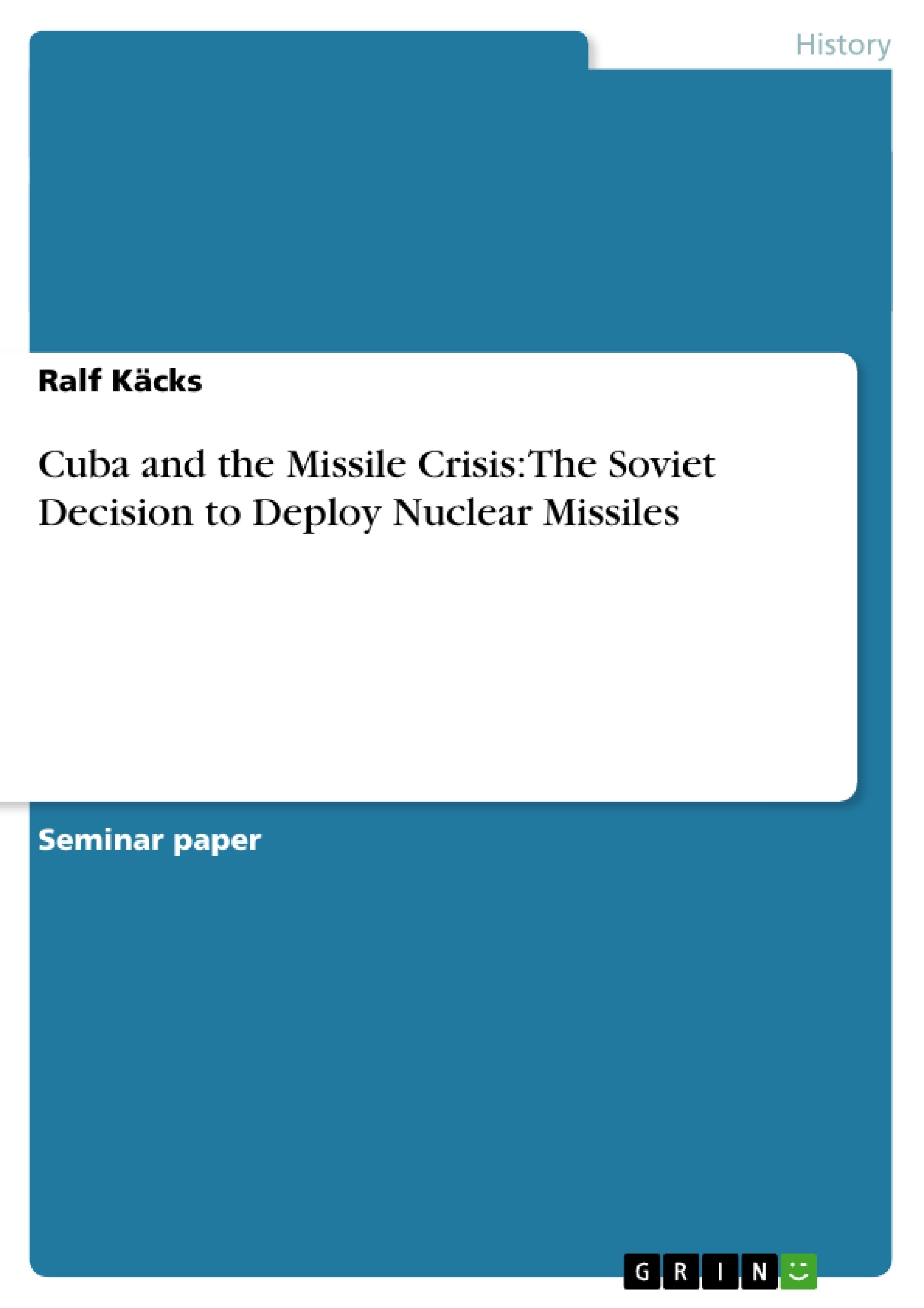It might perhaps be correct to say that never in history has any historical event assembled such great importance in all of its aspects, and been studied in such depth. I believe that is fully understandable, because never before had humankind been so close to the brink of nuclear holocaust.
This short statement by Oleg Troyanovsky reveals that the Cuban missile crisis is indeed one of the most studied subjects in U.S. and Cold War history. Ever since the thirteen days in October 1962 there has been a lively discussion about the origins and the management of the crisis. Despite an enormous range of opinions, and an incredible output of books and articles by participants and scholars of the crisis, most of the approaches were limited to studying the events from an American perspective. However, during the last decade the discussion has continued due to the declassification of secret American documents. In fact it gained new speed after they became available for scholars to review.
One issue that has been heavily disputed since 1962 is the reason for the Soviet missile deployment to Cuba. Even after more than 35 years, it is unclear why Nikita Khrushchev ordered nuclear missiles to be sent to Cuba. Even President John F. Kennedy and his advisers in the Executive Committee (ExComm) could not agree on the reason for the missile deployment. The official Soviet explanation states that the missiles were sent to defend Fidel Castro′s revolution and to deter American aggression in Cuba. However, this theory has been vigorously dismissed as facesaving propaganda for the test-of-will theory which states that the Soviets wanted to probe America′s resolve in Cold War politics.
I will show in this paper that Khruschev did not send the missiles to Cuba because he wanted to directly challenge Kennedy, but rather two reasons were responsible for stationing strategic missiles 90 miles off the U.S. coast. After reconsidering the defense-of-Cuba theme it becomes apparent that the Soviets and the Cubans believed that the deployment of troops and finally nuclear missiles was necessary to save Cuba. This threat perception was not known to the United States. Secondly, American nuclear policy and the Soviet perception of the nuclear situation led to the deployment of Medium Range Ballistic Missiles (MRBMs) and Intermediate Range Ballistic Missiles (IRBMs).
Inhaltsverzeichnis (Table of Contents)
- Introduction
- Testing America's Will or Trading Berlin?
- In Defense of Cuba
- The Nuclear Balance
- Conclusion
Zielsetzung und Themenschwerpunkte (Objectives and Key Themes)
This paper analyzes the Soviet decision to deploy nuclear missiles in Cuba during the 1962 Cuban missile crisis. The author aims to provide a comprehensive account of the crisis, focusing on the Soviet perspective and using recently declassified documents from the Soviet Union.
- The motivations behind the Soviet missile deployment to Cuba
- The role of Cuba in the crisis and its perception of the threat from the United States
- The impact of the nuclear balance and American nuclear policy on the Soviet decision
- The evolution of the crisis and the diplomatic efforts to resolve it
- The long-term implications of the Cuban missile crisis for U.S.-Soviet relations and the Cold War
Zusammenfassung der Kapitel (Chapter Summaries)
- Introduction: This chapter introduces the Cuban missile crisis as one of the most studied subjects in Cold War history and highlights the importance of understanding the Soviet perspective. It also discusses the availability of new information from declassified Soviet documents and the contributions of conferences involving former participants and scholars.
- Testing America's Will or Trading Berlin?: This chapter examines the debate surrounding the reasons for the Soviet missile deployment to Cuba, exploring the "test-of-will" theory and the official Soviet explanation of defending Cuba from American aggression. The author introduces the key players involved in the crisis, such as Nikita Khrushchev and John F. Kennedy.
- In Defense of Cuba: This chapter delves into the Cuban perspective, exploring the threat perception that led to the Soviet deployment of troops and nuclear missiles. It argues that the Soviets and Cubans believed that these actions were necessary to save Cuba from American aggression.
- The Nuclear Balance: This chapter analyzes the role of nuclear weapons and the nuclear balance in the decision-making process. It focuses on the influence of American nuclear policy and the Soviet perception of the nuclear situation in motivating the deployment of Medium Range Ballistic Missiles (MRBMs) and Intermediate Range Ballistic Missiles (IRBMs).
Schlüsselwörter (Keywords)
Key terms and concepts explored in this paper include: Cuban missile crisis, Soviet Union, United States, nuclear weapons, nuclear balance, Cold War, Nikita Khrushchev, John F. Kennedy, Fidel Castro, threat perception, American aggression, defense of Cuba, Medium Range Ballistic Missiles (MRBMs), Intermediate Range Ballistic Missiles (IRBMs), declassified documents, historical analysis, Soviet perspective, diplomacy, international relations.
- Arbeit zitieren
- Ralf Käcks (Autor:in), 1999, Cuba and the Missile Crisis: The Soviet Decision to Deploy Nuclear Missiles, München, GRIN Verlag, https://www.grin.com/document/8327



